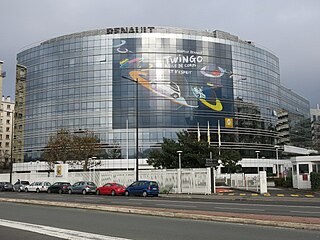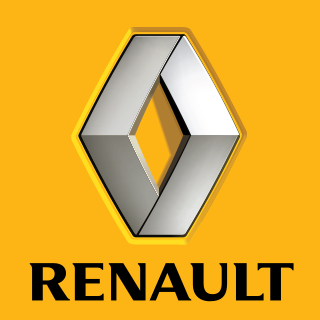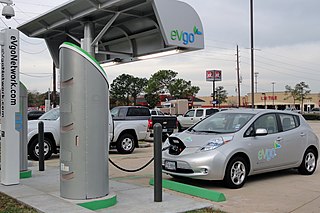
Groupe Renault is a French multinational automobile manufacturer established in 1899. The company produces a range of cars and vans and in the past, has manufactured trucks, tractors, tanks, buses/coaches, aircraft and aircraft engines, and autorail vehicles.

The Renault Kangoo is a family of multi purpose vehicles manufactured and marketed by Renault since 1997, in commercial as well as passenger variants, across three generations. For the European market, the Kangoo is manufactured at the MCA plant in Maubeuge, France.

A Neighborhood Electric Vehicle (NEV) is a U.S. category for battery electric vehicles that are usually built to have a top speed of 25 miles per hour (40 km/h), and have a maximum loaded weight of 3,000 lb (1,400 kg). Depending on the particular laws of the state, they are legally limited to roads with posted speed limits of 35 miles per hour (56 km/h) or less. NEVs fall under the United States Department of Transportation classification for low-speed vehicles. The non-electric version of the neighborhood electric vehicle is the motorized quadricycle.

Practical electric vehicles appeared during the 1890s. An electric vehicle held the vehicular land speed record until around 1900. In the 20th century, the high cost, low top speed, and short-range of battery electric vehicles, compared to internal combustion engine vehicles, led to a worldwide decline in their use as private motor vehicles. Electric vehicles have continued to be used for loading and freight equipment and for public transport – especially rail vehicles.

The Renault Fluence is a compact sedan produced by the French automaker Renault. The car was produced until 2016 at the Oyak-Renault plant in Bursa, Turkey. It was produced until the end of 2018 in Santa Isabel, Argentina, for the Latin American market. Its electric version is still produced in Busan, South Korea, for the market of the Asia-Pacific.

The Renault Samsung SM3 is a compact car produced by the South Korean manufacturer Renault Samsung Motors from 2003 to 2020.

The history of plug-in hybrid electric vehicles (PHEVs) spans a little more than a century, but most of the significant commercial developments have taken place after 2002. The revival of interest in this automotive technology together with all-electric cars is due to advances in battery and power management technologies, and concerns about increasingly volatile oil prices and supply disruption, and also the need to reduce greenhouse gas emissions. Between 2003 and 2010 most PHEVs on the roads were conversions of production hybrid electric vehicles, and the most prominent PHEVs were aftermarket conversions of 2004 or later Toyota Prius, which have had plug-in charging and more lead-acid batteries added and their electric-only range extended.

Sociedad de Fabricación de Automotores (SOFASA) is a Colombian company that assembles imported Renault and, in the past, Toyota and Daihatsu Delta vehicles. It was the first company to produce the Renault Logan in the Americas. In addition to Logan also manufactured Renault Clio, Renault Symbol, Renault Megane and Renault Twingo. It also manufactured trucks like Toyota Prado, Toyota Land Cruiser, Toyota Hilux and Daihatsu Delta. The company exports to the Andean Community of Nations (CAN) and supplies the national market of automobiles in Colombia. Currently, Renault is the sole shareholder of the company. As of 2019 the capacity of the company reached 70 000 cars per year making it the biggest car exporter in the region.

Better Place was a venture-backed international company that developed and sold battery charging and battery switching services for electric cars. It was formally based in Palo Alto, California, but the bulk of its planning and operations were steered from Israel, where both its founder Shai Agassi and its chief investors resided.

An electric car or electric vehicle (EV) is an automobile that is propelled by one or more electric traction motors, using only energy stored in batteries. Compared to conventional internal combustion engine (ICE) vehicles, electric cars are quieter, more responsive, have superior energy conversion efficiency and no exhaust emissions and lower overall vehicle emissions. The term "electric car" normally only specifically refers to battery electric vehicle (BEV), but broadly may also include plug-in hybrid electric vehicle (PHEV), range-extended electric vehicle (REEV) and fuel cell electric vehicle (FCEV).

The Renault Zoe, known as Renault Zoe E-Tech Electric since 2021, is a five-door supermini electric car produced by the French manufacturer Renault. Renault originally unveiled, under the Zoe name, a number of different concept cars. Initially in 2005 as the Zoe City Car and later as the Zoe Z.E. electric concept was shown in two different versions in 2009 and 2010 under the Renault Z.E. name. A production ready version of the Zoe was shown at the 2012 Geneva Motor Show.

A plug-in electric vehicle (PEV) is any road vehicle that can utilize an external source of electricity to store electrical energy within its onboard rechargeable battery packs, to power an electric motor and help propelling the wheels. PEV is a subset of electric vehicles, and includes all-electric/battery electric vehicles (BEVs) and plug-in hybrid electric vehicles (PHEVs). Sales of the first series production plug-in electric vehicles began in December 2008 with the introduction of the plug-in hybrid BYD F3DM, and then with the all-electric Mitsubishi i-MiEV in July 2009, but global retail sales only gained traction after the introduction of the mass production all-electric Nissan Leaf and the plug-in hybrid Chevrolet Volt in December 2010.

Nissan Motors has developed several concept cars and limited production electric cars, and launched the series production Nissan Leaf all-electric car in December 2010. As of December 2015, the Leaf is the world's all-time best selling highway-capable plug-in electric car with over 200,000 units sold since its introduction.

The Renault Fluence Z.E. is an electric version of the Renault Fluence compact sedan, part of the Renault Z.E. program of battery electric vehicles. It was unveiled by Renault at the 2009 Frankfurt Motor Show. The Fluence Z.E. is outfitted with a 22 kWh lithium-ion battery which allows a total all-electric range of 185 km (115 mi) measured on the NEDC combined cycle, with speeds up to 135 km/h (84 mph).

Range anxiety is the driver's fear that a vehicle has insufficient energy storage to cover the road distance needed to reach its intended destination, and would thus strand the vehicle's occupants mid-way. The term, which is now primarily used in reference to the practical driving range of battery electric vehicles (BEVs), is considered to be one of the major psychological barriers to large-scale public adoption of electric cars.

The Renault Twizy is a two-seat electric microcar designed and marketed by Renault. It is classified in Europe as either a light or heavy quadricycle depending on the output power, which is either 4 kW (5.4 hp) for the 45 model or 13 kW (17 hp) for the 80 model, both names reflecting its top speed in km/h. Originally manufactured in Valladolid, Spain, production was moved to Busan in South Korea in March 2019 to meet increased demand in Asia.

The Renault–Nissan–Mitsubishi Alliance, originally known as the Renault–Nissan Alliance, is a French-Japanese strategic alliance between the automobile manufacturers Renault, Nissan and Mitsubishi Motors, which together sell more than 1 in 9 vehicles worldwide. Renault and Nissan have been partners since 1999, and Mitsubishi was added to the alliance in 2017. The partnership was not a merger, but instead the companies have cross ownership, a common relationship between companies in Japan. As of January 2023, Renault and Nissan each own 15% of the shares of the other company and Nissan owns 34% of the shares of Mitsubishi. The structure was unique in the auto industry during the 1990s, an era that saw the mergers of several other manufacturers.

The adoption of plug-in electric vehicles in the France is actively supported by the French government through a bonus–malus system through which provides subsidies towards the purchase of all-electric vehicles and plug-in hybrids with low CO2 emissions. The government also provides non-monetary incentives; subsidies for the deployment of charging infrastructure; and long term regulations with specific targets. Additionally, France passed a law in December 2019 to phase out sales of cars that burn fossil fuels by 2040.
The Common Module Family (CMF) is a modular architecture concept jointly developed by car manufacturers Nissan and Renault through their Renault–Nissan–Mitsubishi Alliance partnership. The concept covers a wide range of vehicle platforms.

























